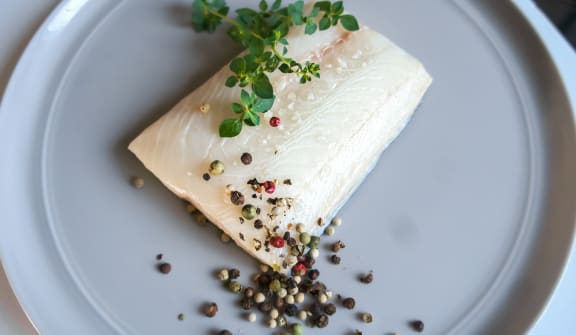After having sablefish broiled Nobu style, you may wonder why you’d ever want to cook it any other way. But a poached fillet of sablefish is equally worthy of your time and appetite. Knowing how to poach sablefish will reveal an especially elegant side of this catch, whose delicacy truly shines when it’s cooked low and slow.
Pick Your Liquids
Sablefish is naturally buttery in flavor, so you’ll want to poach it in a lean but flavorful poaching liquid. This will serve to balance and highlight its richness. Intense flavors tend to work really well with sablefish, so don’t shy away from using salt and acid to complement sablefish’s fattiness.
A water-based poaching liquid seasoned with soy sauce and rice vinegar is simple and delicious. Or, try poaching in a mushroom or veggie stock with a splash of nice vinegar or white wine. Dashi is another great option, complemented by a squeeze of lemon.
Use a Pan That’s Just Right
Find a pan (or pot) that just accommodates your portion (or portions) of sablefish. Using one that is too large won’t hurt the dish, but you’ll need to use more poaching liquid than necessary. The right sized pan keeps things economical, as you'll need just enough liquid to nearly cover the sablefish.
Fine Tune Your Poaching Liquid
Add enough salt/soy to this liquid so that it tastes good, seasoning it as if you were seasoning broth.
Also, taste the liquid to see if there’s enough acid, since vinegars, alcohol, and citrus juices will help to draw out the flavors of any other ingredients you throw into the pot. The broth doesn’t need to be sour, but you do want to be able to taste a hint of acidity.
Add Aromatics
Next, add in aromatics. Try pairing up flavors that are familiar to you so that you know you’re building something that works, but keep the combinations simple:
-
Sliced scallions and a few coins of fresh ginger
- A few sprigs of parsley, chunks of carrots and celery, and a crushed garlic clove
-
A handful of cilantro and a couple slivers of fresh green chili
The Perfect Poach
Bring the poaching liquid to a bare simmer and allow the flavors in the pan to infuse into the liquid. Then, add sablefish to the mix. You want about ¾ of the fish submerged in the pan; it doesn’t matter which side is up. Turn down the heat so that the water is steamy but still, then set your timer for 5 minutes. As your sablefish begins to poach, it will release some of its fats into the water, creating a richer broth; you’ll seem a shimmer of oil floating on the surface of the poaching liquid.
At the 5-minute mark, carefully flip the fillet and allow the sablefish to poach for another 5 minutes. The sablefish is finished when it flakes readily. Another way to know if it’s done is if the skin slips right off the fillet when you pull on it.
Serve your poached sablefish in a shallow bowl on its own, or over a bed of rice/potatoes/noodles/soft-cooked veggies. Make sure to ladle on some of the poaching liquid to enjoy as a mild, tasty broth.
Poached Sablefish Recipe Inspo
This poached sablefish recipe from Monterey Salka utilizes both miso and mushrooms to seriously pump up the umami factor. Or, if you can still get your hands on ripe tomatoes, try this recipe from Food52 for sablefish poached in a veggie-infused chicken broth. There’s also an intriguing recipe on Epicurious for sablefish poached in a five-spice-infused broth, served with udon noodles.






